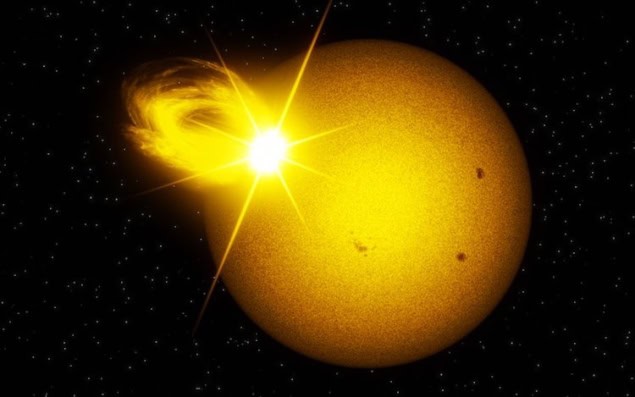
Stars like our own Sun produce “superflares” around once every 100 years, surprising astronomers who had previously estimated that such events occurred only every 3000 to 6000 years. The result, from a team of astronomers in Europe, the US and Japan, could be important not only for fundamental stellar physics but also for forecasting space weather.
The Sun regularly produces solar flares, which are energetic outbursts of electromagnetic radiation. Sometimes, these flares are accompanied by plasma in events known as coronal mass ejections. Both activities can trigger powerful solar storms when they interact with the Earth’s upper atmosphere, posing a danger to spacecraft and satellites as well as electrical grids and radio communications on the ground.
Despite their power, though, these events are much weaker than the “superflares” recently observed by NASA’s Kepler and TESS missions at other Sun-like stars in our galaxy. The most intense superflares release energies of about 1025 J, which show up as short, sharp peaks in the stars’ visible light spectrum.
Observations from the Kepler space telescope
In the new study, which is detailed in Science, astronomers sought to find out whether our Sun is also capable of producing superflares, and if so, how often they happen. This question can be approached in two different ways, explains study first author Valeriy Vasilyev, a postdoctoral researcher at the Max Planck Institute for Solar System Research, Germany. “One option is to observe the Sun directly and record events, but it would take a very long time to gather enough data,” Vasilyev says. “The other approach is to study a large number of stars with characteristics similar to those of the Sun and extrapolate their flare activity to our Sun.”
The researchers chose the second option. Using a new method they developed, they analysed Kepler space telescope data on the fluctuations of more than 56,000 Sun-like stars during the period between 2009‒2013. This dataset, which is much larger and more representative than previous datasets because it based on recent advances in our understanding of Sun-like stars, corresponds to around 220,000 years of solar observations.
The new technique can detect superflares and precisely localize them on the telescope images with sub-pixel resolution, Vasilyev says. It also accounts for how light propagates through the telescope’s optics as well as instrumental effects that could “contaminate” the data.
The team, which also includes researchers from the University of Graz, Austria; the University of Oulu, Finland; the National Astronomical Observatory of Japan; the University of Colorado Boulder in the US; and the Commissariat of Atomic and Alternative Energies of Paris-Saclay and the University of Paris-Cité, both in France; carefully analysed the detected flares. They checked for potential sources of error, such as those originating from unresolved binary stars, flaring M- and K-dwarf stars and fast-rotating active stars that might have been wrongly classified. Thanks to these robust, statistical evaluations, they identified almost 3000 bright stellar flares in the population they observed – a detection rate that implies that superflares occur roughly once per century, per star.
Sun should also be capable of producing superflares
According to Vasilyev, the team’s results also suggest that solar flares and stellar superflares are generated by the same physical mechanisms. This is important because reconstructions of past solar activity, which are based on the concentrations of cosmogenic isotopes in terrestrial archives such as tree rings, tell us that our Sun occasionally experiences periods of higher or lower solar activity lasting several decades.
One example is the Maunder Minimum, a decades-long period during the 17th century when very few sunspots were recorded. At the other extreme, solar activity was comparatively higher during the Modern Maximum that occurred around the mid-20th century. Based on the team’s analysis, Vasilyev says that “so-called grand minima and grand maxima are not regular but tend to cluster in time. This means that centuries could pass by without extreme solar flares followed by several such events occurring over just a few years or decades.”
It is possible, he adds, that a superflare occurred in the past century but went unnoticed. “While we have no evidence of such an event, excluding it with certainty would require continuous and systematic monitoring of the Sun,” he tells Physics World. The most intense solar flare in recorded history, the so-called “Carrington event” of September 1859, was documented essentially by chance: “By the time he [the English astronomer Richard Carrington] called someone to show them the bright glow he observed (which lasted only a few minutes), the brightness had already faded.”

Solar flares are predicted by new model
Between 1996 and 2002, when instruments provided direct measurements of total solar brightness with sufficient accuracy and temporal resolution, 12 flares with Carrington-like energies were detected. Had these flares been aimed at Earth, it is possible that they would have had similar effects, he says.
The researchers now plan to investigate the conditions required to produce superflares. “We will be extending our research by analysing data from next-generation telescopes, such as the European mission PLATO, which I am actively involved in developing,” Vasilyev says. “PLATO’s launch is due for the end of 2026 and will provide valuable information with which we can refine our understanding of stellar activity and even the impact of superflares on exoplanets.”



